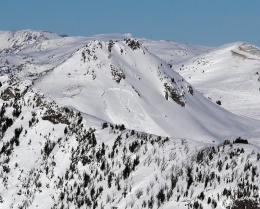Good Morning. This is Eric Knoff with the Gallatin National Forest Avalanche Advisory issued on Saturday, January 6th, 2018 at 6:30 a.m. Today’s advisory is sponsored by PHD Skis and Stronghold Fabrication. This advisory does not apply to operating ski areas.
Cabin Creek Avalanche Accident Report
On Tuesday, January 2nd, a snowmobiler was caught and killed in an avalanche in Cabin Creek to the west of Sage Peak in the southern Madison Range. Alex and Doug investigated the slide on Wednesday. You can view a detailed report of the accident HERE.
Overnight a trace to 1” of snow fell in the mountains south of Bozeman. At 5 a.m. temps are in the upper 20’s to low 30’s F and winds are blowing 10-20 mph out of the west with ridgetop gusts pushing 30 mph. Today, light snow showers will continue to impact the southern mountains including Big Sky, where an additional 1-3” is possible by this evening. Temps today will warm slightly and winds will continue to blow 10-20 mph out of the west. The weak weather disturbance moves out of the area tonight and no snow is expected tomorrow.
Facets buried 2-4’ deep remain a problem across the advisory area, but the likelihood of triggering a slide continues to decrease without new snow and wind. The few inches of snow that will accumulate throughout the day won’t add much stress to instabilities buried deeper in the pack. Isolated wind slabs near upper elevation ridgelines could pose a threat as the day progresses, but these shouldn’t be a major problem.
Today, careful snowpack evaluation remains necessary when traveling in avalanche terrain. Not all slopes are unstable, but some still are. Signs of instability such as cracking and collapsing are minimal right now, so digging down a few feet and doing a stability test is the best way to assess the snowpack structure (video). If tests break clean on the layer of facets 2-4’ deep, avoiding steep slopes is a safe game plan.
As the snowpack trends towards stability, it’s easy to get complacent and let your guard down. It’s important to remember that large and dangerous avalanches are still possible (video, photo). It can’t be emphasized enough how important it is to follow the three simple rules of safe backcountry travel. 1) Everyone has proper rescue gear and knows how to use it. 2) Always watch your partner from a safe location. 3) Only expose one person at a time on steep slopes.
Today, heightened avalanche conditions exist and the avalanche danger is rated MODERATE on all slopes.
Check out pictures that have been added to our Photos page since Monday morning documenting many avalanches.
If you get out and have any avalanche or snowpack observations to share, drop a line via our website, email (mtavalanche@gmail.com), phone (406-587-6984), or Instagram (#gnfacobs).
Upcoming Avalanche Education and Events
BOZEMAN
Jan. 12 and 13, Companion Rescue Clinic, Info and Register
Jan. 17, 18 and 20 or 21, Introduction to Avalanches w/ Field Day, Info and Register Here
Jan. 24, 25 and 27, Advanced Avalanche Workshop w. Field Day, Info and Register Here
Feb. 9 and 10, Companion Rescue Clinic, Info and Register
WEST YELLOWSTONE
Jan. 6, Avalanche Awareness, 7-8 p.m. at West Yellowstone Holiday Inn Conference Center
BIG TIMBER
Jan. 11, Avalanche Awareness, 6-7 p.m. at Sweet Grass County High School
BUTTE
Jan. 13, Rescue Clinic, 10 a.m. at Homestake Lodge
Dillon
Jan. 16, Avalanche Awareness, 6:30-8 p.m. at U.M. Western Library
COOKE CITY
Every Friday and Saturday, Current Conditions Update and Avalanche Rescue, Friday 6:30-7:30 p.m. at The Antler's Lodge in January. Saturday anytime between 10-2 @ Lulu Pass road.
Check out Dashboard Talks: Episode 2, a 2.5-minute video of Dave Zinn and Doug Chabot discussing how often you should practice with your rescue gear.


